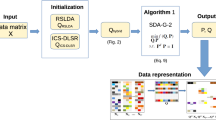Abstract
This paper presents a general and unifying optimization framework for the problem of feature extraction and reduction for high-dimensional pattern classification of medical images. Feature extraction is often an ad hoc and case-specific task. Herein, we formulate it as a problem of sparse decomposition of images into a basis that is desired to possess several properties: 1) Sparsity and local spatial support, which usually provides good generalization ability on new samples, and lends itself to anatomically intuitive interpretations; 2) good discrimination ability, so that projection of images onto the optimal basis yields discriminant features to be used in a machine learning paradigm; 3) spatial smoothness and contiguity of the estimated basis functions. Our method yields a parts-based representation, which warranties that the image is decomposed into a number of positive regional projections. A non-negative matrix factorization scheme is used, and a numerical solution with proven convergence is used for solution. Results in classification of Alzheimers patients from the ADNI study are presented.
Preview
Unable to display preview. Download preview PDF.
Similar content being viewed by others
References
Teipel, S.J., Born, C., Ewers, M., Bokde, A.L., Reiser, M.F., Müller, H.J., Hampel, H.: Multivariate deformation-based analysis of brain atrophy to predict alzheimer’s disease in mild cognitive impairment. NeuroImage 38(1), 13–24 (2007)
Hua, X., et al.: 3D characterization of brain atrophy in alzheimer’s disease and mild cognitive impairment using tensor-based morphometry. NeuroImage 41(1), 19–34 (2008)
Davatzikos, C., Genc, A., Xu, D., Resnick, S.M.: Voxel-based morphometry using the ravens maps: Methods and validation using simulated longitudinal atrophy. NeuroImage 14(6), 1361–1369 (2001)
Wright, I.C., McGuire, P.K., Poline, J.B., Travere, J.M., Murray, R.M., Frith, C.D., Frackowiak, R.S.J., Friston, K.J.: A voxel-based method for the statistical analysis of gray and white matter density applied to schizophrenia. Neuroimage 2(4), 244–252 (1995)
Ashburner, J., Friston, K.J.: Voxel-based morphometry-the methods. NeuroImage 11(6), 805–821 (2000)
Snook, L., Plewesa, C., Beaulieu, C.: Voxel based versus region of interest analysis in diffusion tensor imaging of neurodevelopment. NeuroImage 34(1), 243–252 (2007)
Salmon, E., Collette, F., Degueldre, C., Lemaire, C., Franck, G.: Voxel-based analysis of confounding effects of age and dementia severity on cerebral metabolism in alzheimer’s disease. Human Brain Mapping 10(1), 39–48 (2000)
Davatzikos, C.: Why voxel-based morphometric analysis should be used with great caution when characterizing group differences. NeuroImage 23, 17–20 (2004)
Fan, Y., Shen, D., Gur, R.C., Gur, R.E., Davatzikos, C.: Compare: Classification of morphological patterns using adaptive regional elements. IEEE Trans. on Med. Imag. 26(1), 93–105 (2007)
Csernansky, J.G., Joshi, S., Wang, L., Haller, J.W., Gado, M., Miller, J.P., Grenander, U., Miller, M.I.: Hippocampal morphometry in schizophrenia by high dimensional brain mapping. Proceedings of the National Academy of Sciences 95(19), 11406–11411 (1998)
Thomaz, C., Boardman, J., Counsell, S., Hill, D., Hajnal, J., Edwards, A., Rutherford, M., Gillies, D., Rueckert, D.: A multivariate statistical analysis of the developing human brain in preterm infants. Image and Vision Computing 25(6), 981–994 (2007)
Lashkari, D., Vul, E., Kanwisher, N., Golland, P.: Discovering structure in the space of activation profiles in fMRI. In: Metaxas, D., Axel, L., Fichtinger, G., Székely, G. (eds.) MICCAI 2008, Part I. LNCS, vol. 5241, pp. 1015–1024. Springer, Heidelberg (2008)
Terriberry, T.B., Joshi, S.C., Gerig, G.: Hypothesis testing with nonlinear shape models. Inf. Process. Med. Imaging 3565(19), 15–26 (2005)
Guyon, I., Elisseeff, A.: An introduction to variable and feature selection. Journal of Machine Learning Research 3, 1157–1182 (2003)
Guyon, I., Weston, J., Barnhill, S., Vapnik, V.: Gene selection for cancer classification using support vector machines. Machine Learning 46, 389–422 (2002)
Lee, D.D., Seung, H.S.: Algorithms for non-negative matrix factorization, 556–562 (2000)
Donoho, D., Stodden, V.: When does non-negative matrix factorization give a correct decomposition into parts? In: NIPS, vol. 16, pp. 1141–1148 (2004)
Sra, S., Dhillon, I.S.: Technical report, Dept. Computer Science, University of Texas at Austin, Austin, TX 78712, USA (June)
Feng, T., Li, S., Shum, H.Y., Zhang, H.: Local non-negative matrix factorization as a visual representation. In: The 2nd International Conference on Development and Learning (2002)
Zdunek, R., Cichocki, A.: Blind image separation using nonnegative matrix factorization with gibbs smoothing. In: Ishikawa, M., Doya, K., Miyamoto, H., Yamakawa, T. (eds.) ICONIP 2007, Part II. LNCS, vol. 4985, pp. 519–528. Springer, Heidelberg (2008)
Wang, Y., Jia, Y., Hu, C., Turk, M.: Fisher non-negative matrix factorization for learning local features. In: Proc. Asian Conf. on Comp. Vision (2004)
Dempster, A.P., Laird, N.M., Rubin, D.B.: Maximum likelihood from incomplete data via the em algorithm. Journal of the Royal Statistical Society, Series B 39(1), 1–38 (1977)
Shen, D., Davatzikos, C.: Very high resolution morphometry using mass-preserving deformations and hammer elastic registration. NeuroImage 18, 28–41 (2003)
Witten, I.H., Frank, E.: Data Mining: Practical Machine Learning Tools and Techniques, 2nd edn. Elsevier, Amsterdam (2005)
Author information
Authors and Affiliations
Editor information
Editors and Affiliations
Rights and permissions
Copyright information
© 2009 Springer-Verlag Berlin Heidelberg
About this paper
Cite this paper
Batmanghelich, N., Taskar, B., Davatzikos, C. (2009). A General and Unifying Framework for Feature Construction, in Image-Based Pattern Classification. In: Prince, J.L., Pham, D.L., Myers, K.J. (eds) Information Processing in Medical Imaging. IPMI 2009. Lecture Notes in Computer Science, vol 5636. Springer, Berlin, Heidelberg. https://doi.org/10.1007/978-3-642-02498-6_35
Download citation
DOI: https://doi.org/10.1007/978-3-642-02498-6_35
Publisher Name: Springer, Berlin, Heidelberg
Print ISBN: 978-3-642-02497-9
Online ISBN: 978-3-642-02498-6
eBook Packages: Computer ScienceComputer Science (R0)




